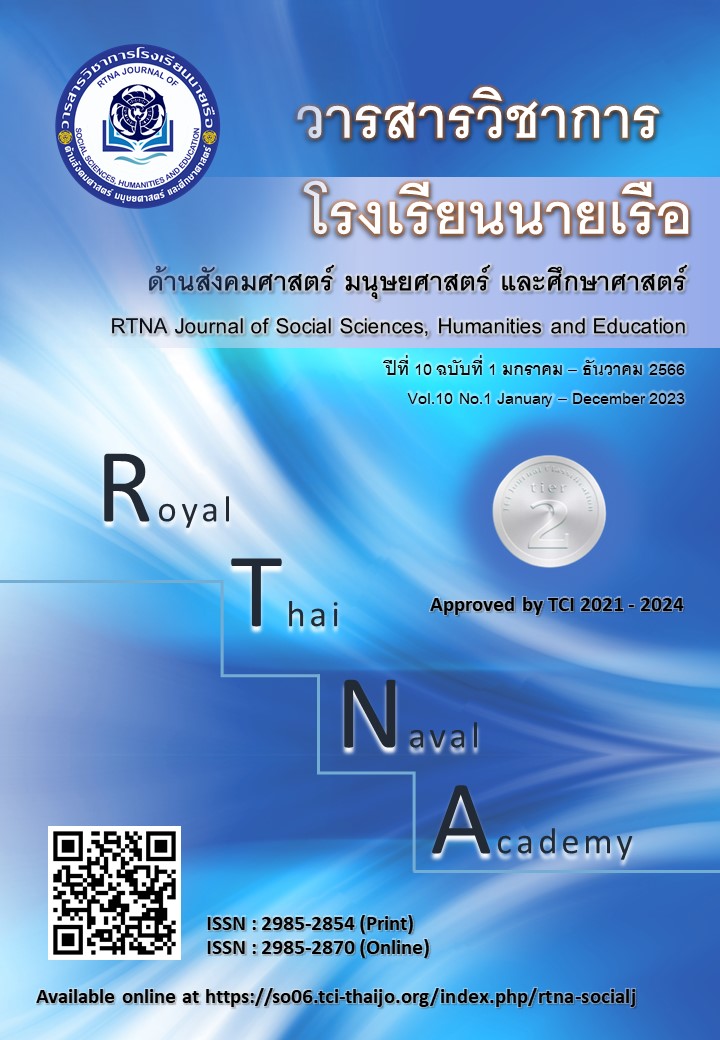Property of measuring teachers' basic ICT competence beliefs of teachers in the Primary Educational Service Area Office, Phitsanulok
Keywords:
Test, Beliefs, ICT Competence BeliefsAbstract
The purpose of this research aims to study the suitability of belief-related practice of information and communication technology (ICT) of Charlott Rubach and Rebecca Lazarides in Thai version. The study groups are 380 teachers, academic year 2565, in the Primary Educational Service Area Office, Phitsanulok province. The study tools, the belief-related practice of information and communication technology (ICT) of Charlott Rubach and Rebecca Lazarides, were two parts. The first part is the general information of respondents, and the second part is beliefs related to information and communication technology (ICT) in basic. There were 32 items questionnaires composed of six components which were information and data literacy, communication and collaboration, digital content creation, safety and security, problem solving, and analyzing and reflecting. The result revealed that the belief related practice of information and communication technology (ICT) had a relatively high level of reliability = 0.804 regarding survey of the factorial structure directly. Belief related practice of information and communication technology (ICT), by confirmatory factor analyses to investigate found that model correlates with the empirical data by considering the Harmony Level Index met the specified criteria. The results were as followings, = 421.824, df = 381, /df =1.107, p-value = 0.0731, RMSEA = 0.017, CFI = 0.980, TLI = 0.975 and SRMR = 0.043.
References
กระทรวงศึกษาธิการ. (2564). แผนปฏิบัติการดิจิทัลเพื่อการศึกษา กระทรวงศึกษาธิการ พ.ศ. 2563 - 2565. พิมพ์ครั้งที่ 2. กรุงเทพฯ: ศูนย์เทคโนโลยีสารสนเทศและการสื่อสาร.
จุฬารัตน์ ธรรมประทีป. (2559). การพัฒนาความรู้ในเนื้อหาผนวกวิธีสอนและเทคโนโลยีในการสอนวิทยาศาสตร์. วารสารวิจัยและพัฒนาหลักสูตร, 6(2), 1-13.
ชัยวัฒน์ ชนะมี. (2557). การวิเคราะห์พหุระดับปัจจัยที่สัมพันธ์กับจิตวิทยาศาสตร์ของนักเรียนชั้นมัธยมศึกษาตอนปลาย สำนักงานเขตพื้นที่การศึกษามัธยมศึกษา เขต 36. (ปริญญาศึกษาศาสตรมหาบัณฑิต สาขาวิชาวิจัยและสถิติการศึกษา). เชียงใหม่: มหาวิทยาลัยเชียงใหม่.
ณัฐิกานต์ ปังศรีวงศ์. (2563). การพัฒนาทักษะด้านการใช้เทคโนโลยีสารสนเทศและการสื่อสารเพื่อการจัดการเรียนรู้ ในศตวรรษที่ 21 ของครูโรงเรียนตลาดหนองหวาย สังกัดสำนักงานเขตพื้นที่ การศึกษาประถมศึกษาสุราษฎร์ธานี เขต 2. (ครุศาสตรมหาบัณฑิต สาขาวิชาการบริหารการศึกษา). สุราษฎร์ธานี: มหาวิทยาลัยราชภัฏสุราษฎร์ธานี.
ทรูปลูกปัญญา. (2565). จากครูสู่ผู้อำนวยการเรียนรู้ (From Teacher to Facilitator). สืบค้นจาก https://www.trueplookpanya.com/education/content/50208
นงลักษณ์ วิรัชชัย. (2542). โมเดลลิสเรล: สถิติวิเคราะห์สำหรับการวิจัย. (พิมพ์ครั้งที่ 3). กรุงเทพฯ: จุฬาลงกรณมหาวิทยาลัย.
พระราชบัญญัติการศึกษาแห่งชาติ. (2542). พระราชบัญญัติการศึกษาแห่งชาติ พ.ศ. 2542 กระทรวงศึกษาธิการ.สืบค้นจาก https://www.moe.go.th/พรบ-การศึกษาแห่งชาติ-พ-ศ-2542/
พิมพันธ์ เดชะคุปต์ และพรทิพย์ แข็งขัน. (2551). สมรรถนะครูและแนวทางการพัฒนาครูในสังคมที่เปลี่ยนแปลง. กรุงเทพฯ: สำนักงานเลขาธิการสภาการศึกษา กระทรวงศึกษาธิการ.
มนฤดี ช่วงฉ่ำ และคณะ. (2564). พฤติกรรมการใช้เทคโนโลยีสารสนเทศและการสื่อสารเพื่อประสิทธิภาพการสอนของครู สังกัดสำนักงานเขตพื้นที่การศึกษามัธยมศึกษาเขต 5 : ความหมายและปัจจัยเงื่อนไข. (ปรัชญาดุษฎีบัณฑิต สาขาวิชาจิตวิทยาอุตสาหกรรมและองค์การ). กรุงเทพฯ: มหาวิทยาลัยเทคโนโลยีพระจอมเกล้าพระนครเหนือ.
ยศวีร์ สายฟ้า. (2563). ทิศทางการผลิตครูประถมศึกษาของประเทศไทยที่ตอบสนองความต้องการของผู้ใช้ครูกับการเปลี่ยนแปลงของสังคมในยุคดิจิทัล. กรุงเทพฯ: ภาควิชาหลักสูตรและการสอน คณะครุศาสตร์ จุฬาลงกรณ์มหาวิทยาลัย.
วีรวิชญ์ เลิศรัตน์ธำรงกุล. (2564). การกลั่นแกล้งกันในพื้นที่ไซเบอร์ของนักเรียนระดับมัธยมศึกษาตอนต้น: ความชุก วิธีการจัดการปัญหา และพฤติกรรมเสี่ยง. วารสารวิชาการและวิจัย มหาวิทยาลัยภาคตะวันออกเฉียงเหนือ, 11(1), 275 - 289.
สุภมาส อังศุโชติ และคณะ. (2551). สถิติวิเคราะห์สําหรับการวิจัยทางสังคมศาสตร์และพฤติกรรมศาสตร์ : เทคนิคการใช้โปรแกรม LISREL. กรุงเทพฯ: มิสชั่นมีเดีย.
อนิวัช แก้วจำนงค์. (2564). แนวคิดเกี่ยวกับการวัด ปัจจัยที่มีผลต่อความคลาดเคลื่อนจากการวัด
การตรวจสอบคุณภาพความตรง และความเที่ยงของเครื่องมือวิจัย. ใน การประชุมโครงการฝึกอบรม สร้างนักวิจัยรุ่นใหม่ มหาวิทยาลัยอุบลราชธานี รุ่นที่ 8. อุบลราชธานี: มหาวิทยาลัยอุบลราชธานี.
Bandura, A. (1986). Social Foundations of Thought and Action: A Social Cognitive Theory. New Jersey: Prentice Hall.
Dominic, R. P., & Terence, J. G. T. (2010). Psychometric properties of the career clusters Interest survey. Journal of Career Assessment, 18(2), 177-188.
Muenks, K., Wigfield, A., & Eccles, J. S. (2018). I can do this! the development and calibration of children's expectations for success and competence beliefs. Developmental Review, 48, 24-39. https://doi.org/10.1016/j.dr.2018.04.001
Rubach, C. & Lazarides, R. (2021). Addressing 21st-century digital skills in schools – Development and validation of an instrument to measure teachers' basic ICT competence beliefs. Computers in Human Behavior, 118. https://doi.org/10.1016/j.chb.2020.106636
Downloads
Published
Issue
Section
License
Copyright (c) 2023 Royal Thai Naval Academy

This work is licensed under a Creative Commons Attribution-NonCommercial-NoDerivatives 4.0 International License.
The author has the sole responsibility for the material published in RTNA Journal of Social Sciences, Humanities, and Education, which the editorial team may not agree on that material.
RTNA Journal of Social Sciences, Humanities, and Education owns the copyright of the text, the illustration, or other material published in the journal. No parts or the whole of the material published may be disseminated or used in any form without first obtaining written permission from the academy.






